
Jökulsá á Fjöllum Glacial River and the magnificent Waterfalls in Jökulsárgljúfur Canyon

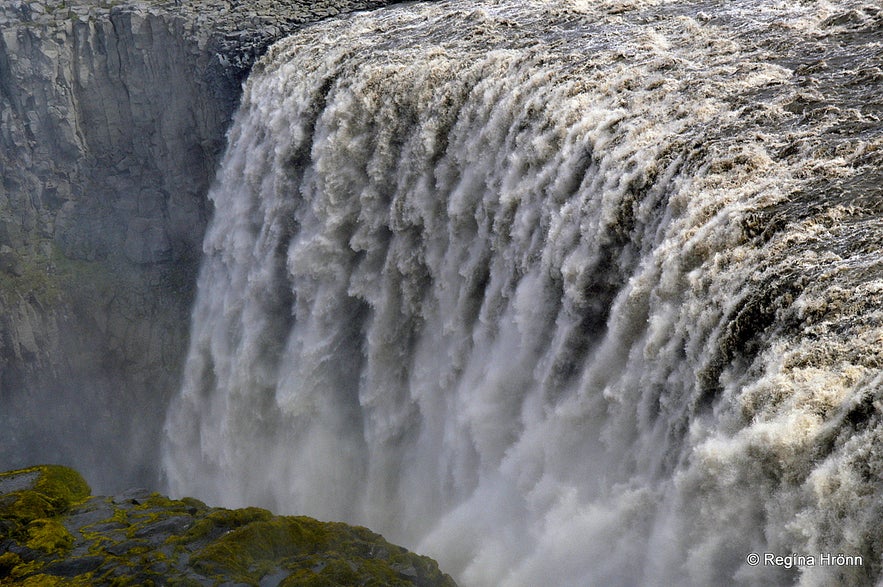
Jökulsá á Fjöllum is a roaring, turbulent milky white/greyish glacial river coming straight from Vatnajökull, Iceland's largest glacier, or its glacier tongue Dyngjujökull to be exact.
Opening photo: Jökulsá á Fjöllum and Dettifoss
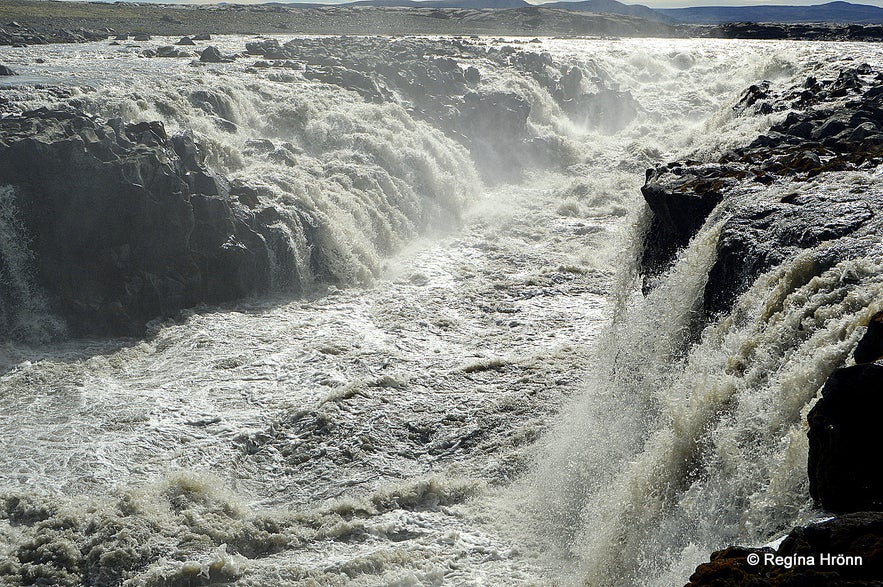 Jökulsá á Fjöllum glacial river in the highland and Gljúfrasmiður waterfall
Jökulsá á Fjöllum glacial river in the highland and Gljúfrasmiður waterfall
I am going to show you what the glacial river looks like in the highland and all the way down to its estuary in Öxarfjörður fjord. Along the way, the glacial river creates extraordinary waterfalls.
My second photo is taken in the highland of Iceland in the vicinity of Askja caldera and the small, but powerful waterfall in the glacial river is called Gljúfrasmiður - the Canyon Builder.
I have twice visited this area on the way to Askja in the highland. As this is such a rugged area with glacial rivers to cross then I joined guided tours.
 The massive bridge over Jökulsá á Fjöllum
The massive bridge over Jökulsá á Fjöllum
Jökulsá á Fjöllum glacial river is bridged in 3 places and on our travels in the highlands of Iceland we crossed the glacial river on the bridge by Upptyppingar.
The other two bridges are by ring-road 1 and by the end of the Jökulsárgljúfur canyon by road 85.
Jökulsá á Fjöllum glacial river runs through one of the biggest canyons in Iceland, the 25 km long ruggedly beautiful Jökulsárgljúfur canyon, with its beautiful waterfalls and extraordinary rock formations.
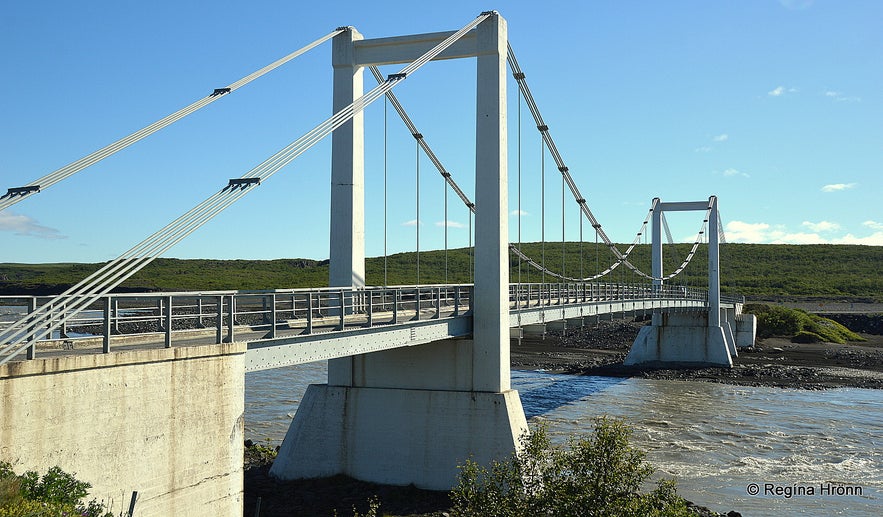
Jökulsárbrú bridge by road 85 close to the estuary of Jökulsá á Fjöllum glacial river
In the Jökulsárgljúfur canyon, the glacial river creates the most powerful waterfall in Iceland, the Dettifoss waterfall, plus several other smaller waterfalls.
Jökulsárgljúfur canyon is my favourite canyon in Iceland and I never tire of hiking in this extraordinary canyon and in Ásbyrgi, which is my favourite spot in Iceland. Too bad that it is so far from Reykjavík where I live.
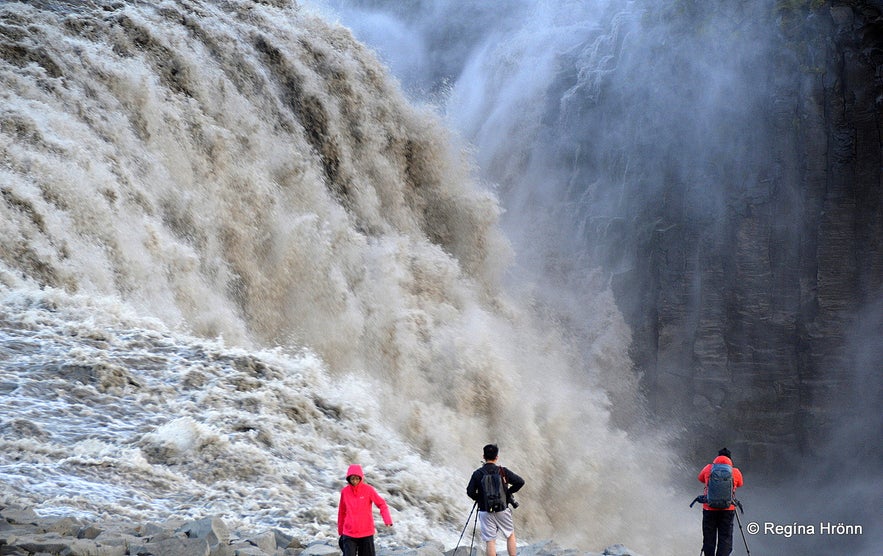
Dettifoss waterfall from the east bank
Dettifoss, along with the smaller waterfalls, Selfoss and Hafragilsfoss, which are south and north of Dettifoss, have been declared protected.
You will also find a very pretty horseshoe-shaped waterfall further down the canyon called Réttarfoss waterfall.
Selfoss waterfall
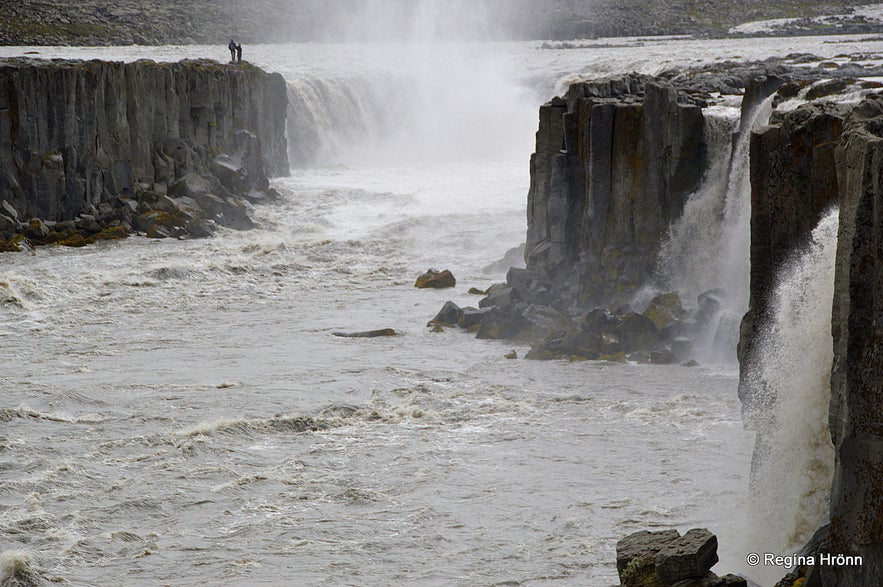 Selfoss as seen from the west bank - there is so much mist by the waterfall
Selfoss as seen from the west bank - there is so much mist by the waterfall
The first waterfall in the canyon is called the Selfoss waterfall.
It is a beautiful horseshoe-shaped waterfall, 10 meters high and very wide.
I first visited it from the west bank of the glacial river, but it cannot be seen very well from there.
From the east bank, there is a 1.4 km hike from Dettifoss waterfall.
I have visited Selfoss from that side of the river as well, and parts of it are very rocky, nothing major though, just wear good hiking shoes.
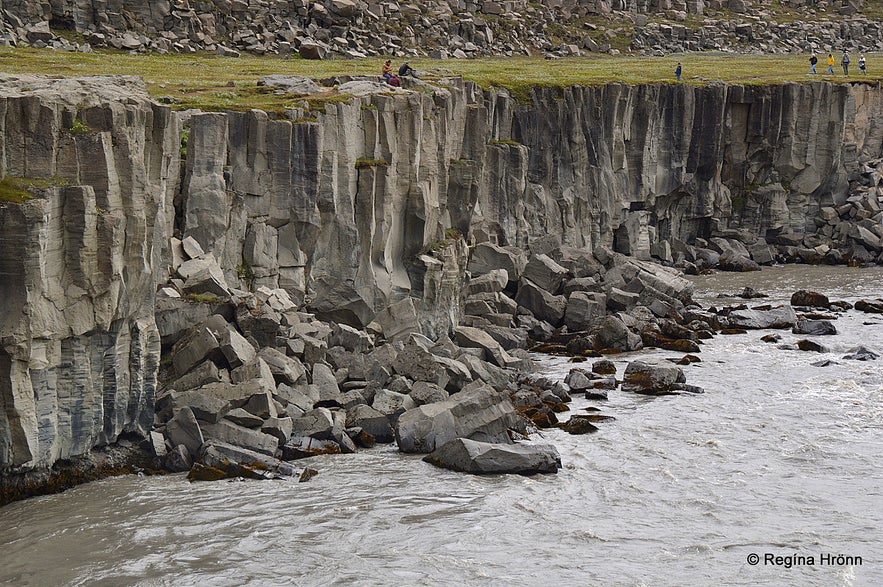 Basalt columns as seen from the west bank by Selfoss waterfall - don't sit or walk too close to the edge
Basalt columns as seen from the west bank by Selfoss waterfall - don't sit or walk too close to the edge
I took a video of Selfoss from the east bank and got quite dizzy while filming this forceful glacial river up close. So let's be careful here.
There are some very beautiful basalt columns on each side of Jökulsá á Fjöllum glacial river by Selfoss.
As you can see in my photo above then many of the basalt columns have collapsed into the river, so stay away from the edges.
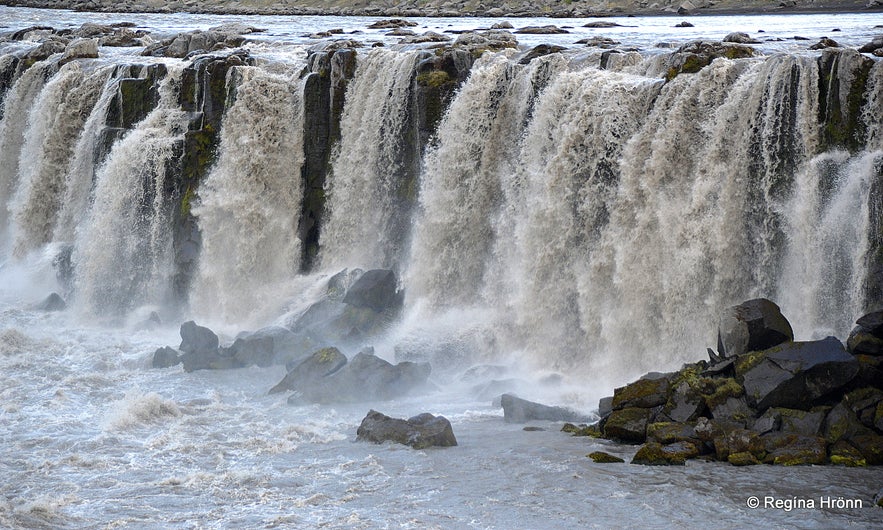
Selfoss waterfall
There is a town in South Iceland called Selfoss, but it has nothing to do with this waterfall.
I have noticed though that some people get confused when they come to Selfoss town and see no waterfall, as "foss" in Icelandic means a waterfall.
Dettifoss waterfall - the most powerful of Iceland's waterfalls
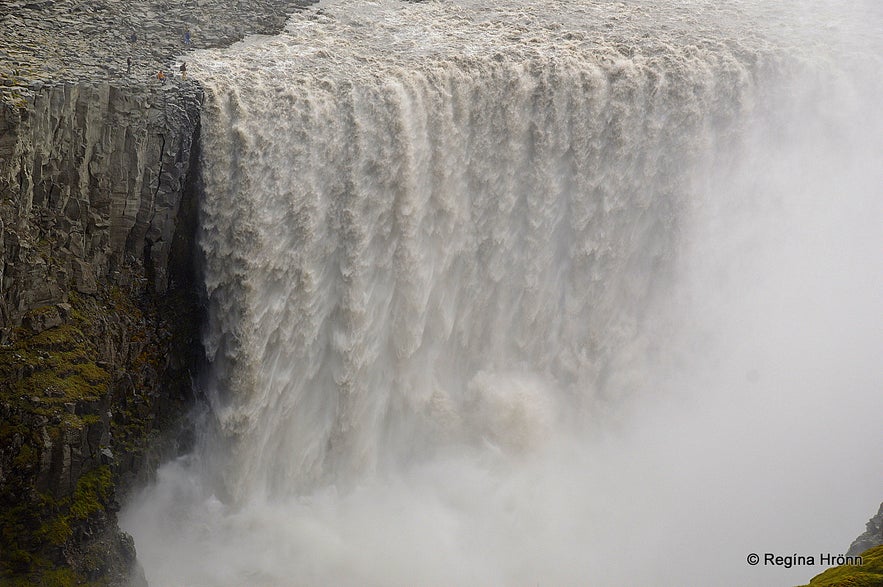 Dettifoss as seen from the west bank
Dettifoss as seen from the west bank
Now let's visit Dettifoss waterfall. Dettifoss is Iceland's most powerful waterfall and it has got the wow factor big time. It is 44 meters high and 100 meters wide and has a flow of 193 m3/s.
Dettifoss can be visited from both the east bank and the west bank of Jökulsá á Fjöllum glacial river and there is a totally different experience visiting it from the east bank than visiting it from the west bank.

It is awesome standing close to Dettifoss. When I visit it I am always in awe of how powerful it really is. I get a feeling of unreality standing so close to such forces of nature.
There is a lot of mist on the west bank so one is bound to get wet when standing so close to this powerful waterfall.
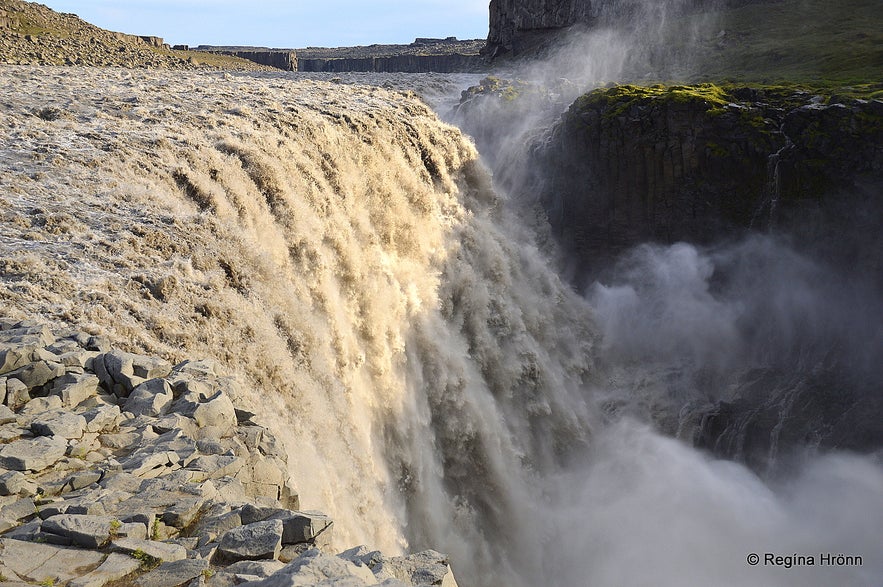 Dettifoss from the east bank
Dettifoss from the east bank
The road to the west is paved, but the road on the east side is still a bumpy gravel road.
There is a 15-minute hike down to the waterfall from the parking lot on the west bank. And from the east bank stone steps lead into the canyon.
From the east bank you can stand even closer to the mammoth roaring falls. I took a video of it:
This is nature at its most powerful, and one can easily feel dizzy when standing too close to the edge, especially when taking photos or a video.
There are some guardrails here, and some ropes have been put up in the last couple of years, but let's be very careful here.
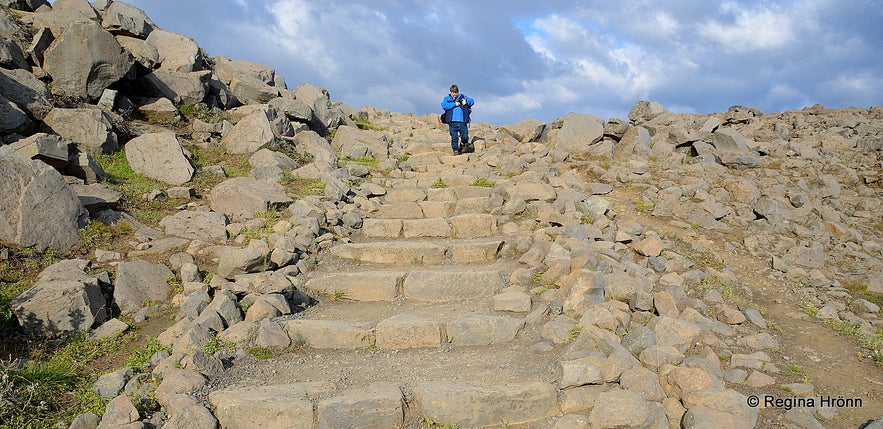 Steps leading into Jökulsárgljúfur canyon
Steps leading into Jökulsárgljúfur canyon
We, locals, are brought up to fear the forceful glacial rivers and waterfalls, so we don't take any risks in Icelandic nature and respect it.
But I have seen people taking very foolhardy risks here and my heart always sinks when I see such reckless behaviour.
Most of them listen to us locals when we warn them against the dangers that seem obvious to us, but there are always a few of them that are adamant to risk their lives.
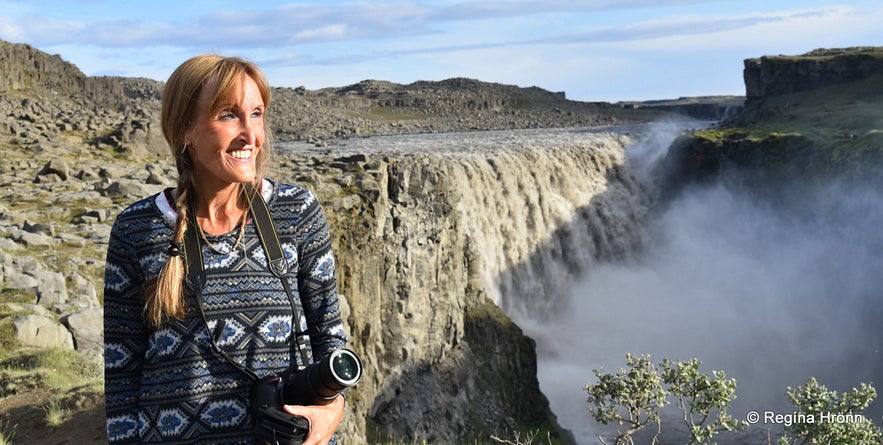
Visiting Dettifoss from the east bank
A couple of hundred meters below Dettifoss waterfall you will find Hafragilsfoss waterfall.
Hafragilsfoss is also a beautiful waterfall, less visited than Dettifoss.
Hafragilsfoss waterfall
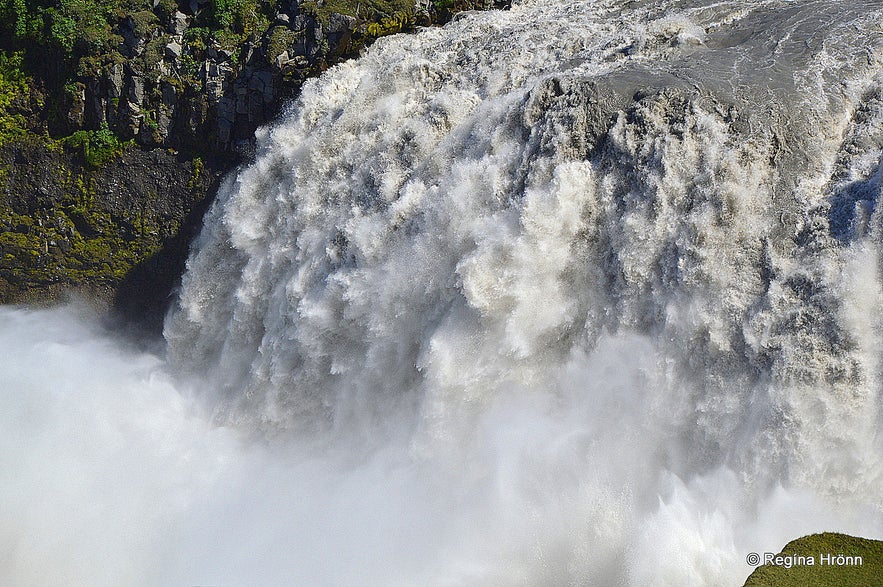 Hafragilsfoss as seen from the west side
Hafragilsfoss as seen from the west side
Hafragilsfoss waterfall is 27 meters high and 91 meters wide, a mini Dettifoss.
This part of the canyon is called Hafragilsundirlendi and it is so beautiful. Here the canyon is 100 meters deep. The photo above shows you the waterfall from the west side.
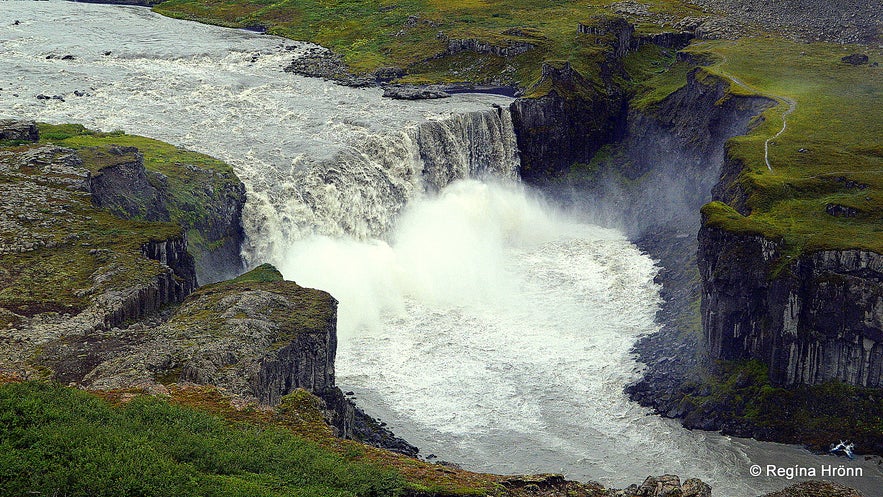 Hafragilsfoss as seen from the east bank
Hafragilsfoss as seen from the east bank
There are several freshwater springs here creating lovely small waterfalls that run into the glacial river Jökulsá á Fjöllum.
And where the freshwater meets the ice-cold grey glacial water the most beautiful blue and aquamarine colours appear.
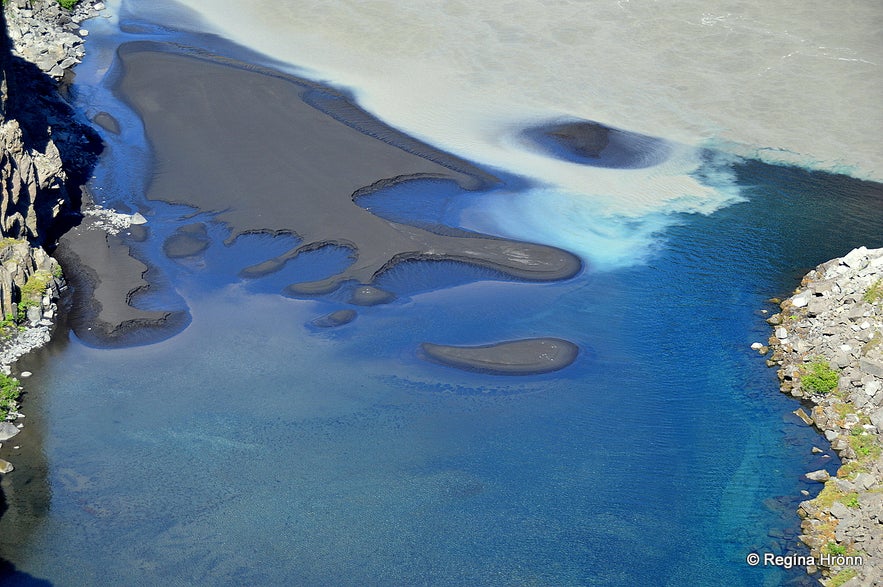
Hafragilsundirlendi from the west bank - here freshwater rivers meet Jökulsá á Fjöllum
The name Hafragilsfoss means Buck Canyon fall.
According to folklore, a giantess took 2 bucks in Öxarfjörður fjord, north of Jökulsárgljúfur canyon, where Jökulsá á Fjöllum glacial river ends its course and joins the sea.
She took these bucks to feed a shepherd she had kidnapped.
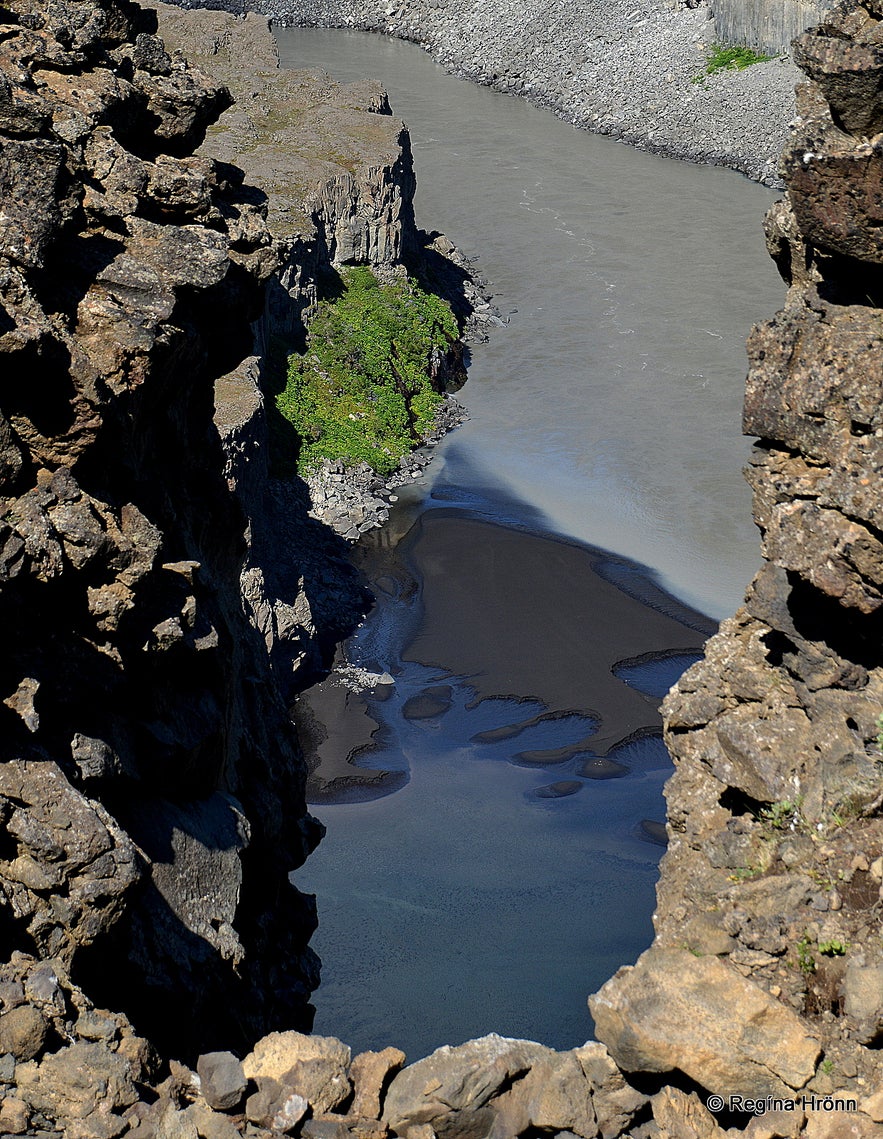 Looking into Jökulsá á Fjöllum
Looking into Jökulsá á Fjöllum
The giantess tied the bucks together by their horns, threw them up on her shoulder, and jumped over the glacial river on this spot.
She sat down to rest and let the bucks graze - this spot has since that time been called Hafragil - Buck gorge.
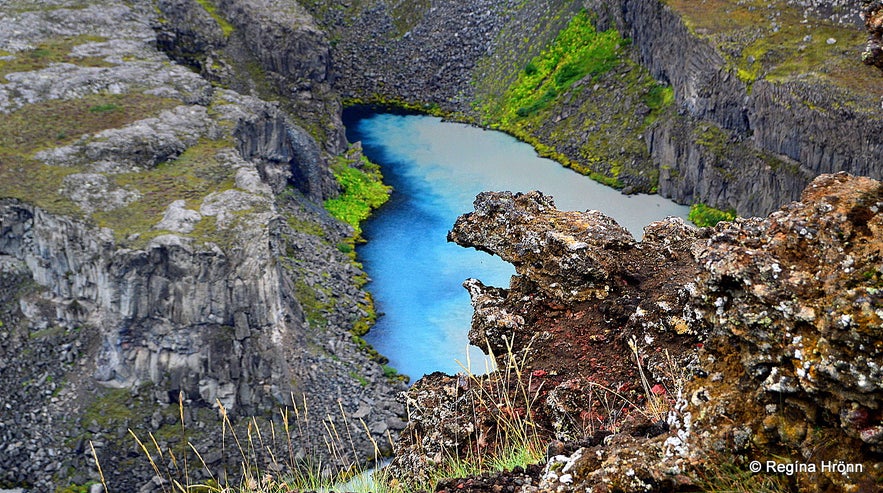 Hafragilsundirlendi as seen from the east bank
Hafragilsundirlendi as seen from the east bank
There is another folklore that tells us that Grettir sterki - Grettir the Strong did this jump, but one of his lairs, Grettisbæli, can be found in Vígabjarg by Forvöð a little further in Jökulsárgljúfur canyon.
Hafragilsfoss waterfall has got a huge mist/spray and resembles Dettifoss, only on a smaller scale.
From both the west bank and the east bank you will have a great view of the Jökulsárgljúfur canyon and the glacial river Jökulsá á Fjöllum.
From the west bank, you have a fantastic view of what I like to call an elf church.
 Hafragilsfoss as seen from the west bank
Hafragilsfoss as seen from the west bank
Don't you agree with me on this - doesn't the basalt-column rock in my photo below looks just like an elf church?
We have got many stories of encounters with the elves - hidden people - of Iceland and many people have seen them through the ages enter rocks that might have been their churches or their habitations.
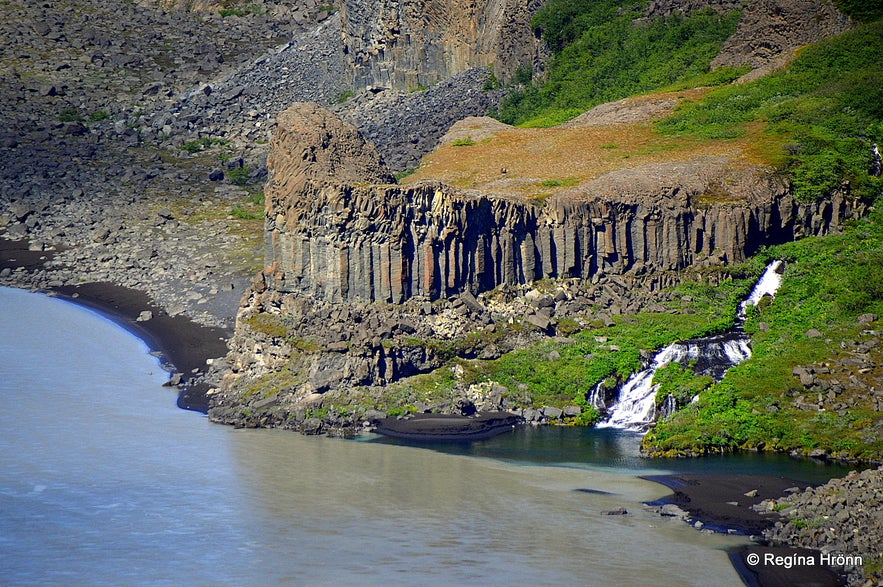
Photo shot from the west bank - amazing basalt column formations
I have written many travel-blogs about the habitations and churches of the elves. But I have not been able to find any folklore about the elves for this particular rock but would like to believe that one exists.
Forvöð and Réttarfoss waterfall
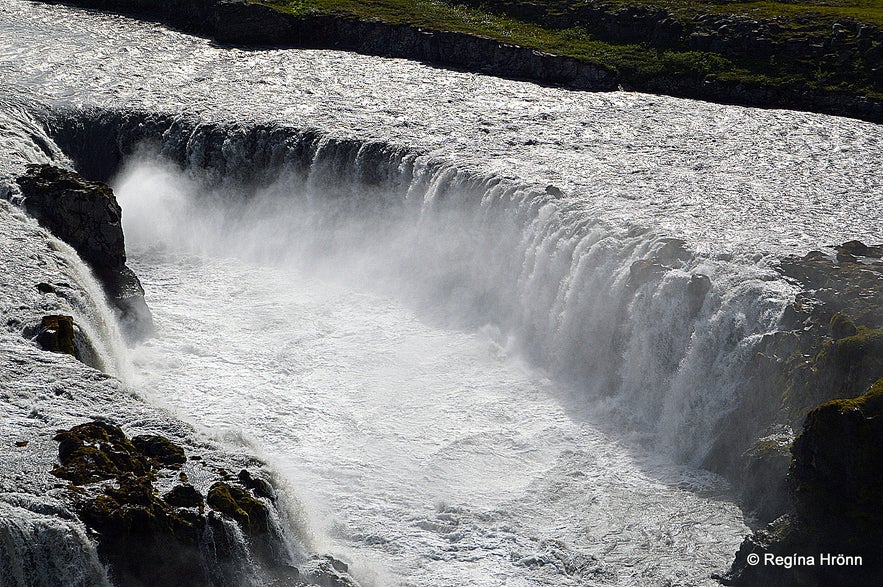 Réttarfoss from the east bank
Réttarfoss from the east bank
Another beautiful location in Jökulsárgljúfur canyon is Forvöð and Réttarfoss waterfall where you can reach the waterfall from the east side.
By Forvöð in Jökulsárgljúfur canyon, there is an hour's hike down to a horseshoe-shaped waterfall called Réttarfoss waterfall.
This is a very interesting hike with lots of beautiful, basalt column formations and historical sights, f.ex. one of the Grettisbæli - the Lair of Grettir the Strong - is to be found at Forvöð.
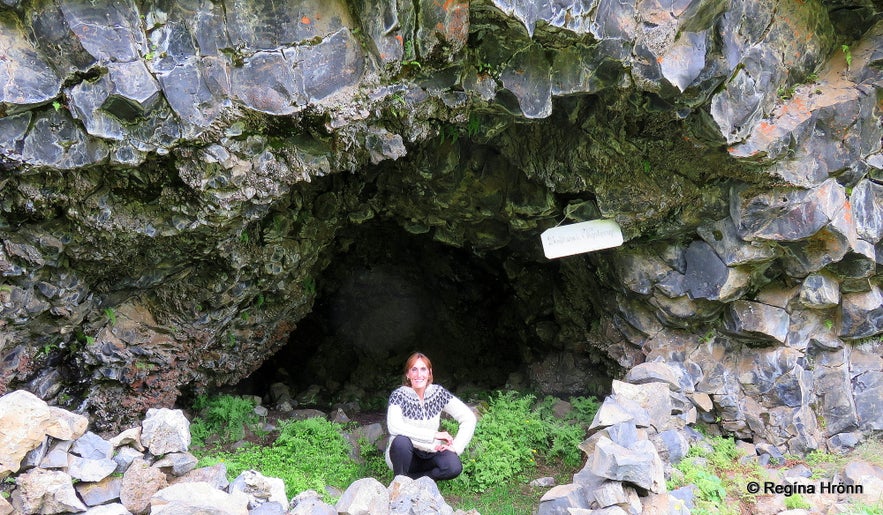 Grettisbæli - one of the lairs of Grettir the Strong in Vígabjarg in Jökulsárgljúfur canyon
Grettisbæli - one of the lairs of Grettir the Strong in Vígabjarg in Jökulsárgljúfur canyon
You can also visit Hólmatungur from the west side which is a breathtaking area, which has become one of my favourite areas in Iceland.
From there you can hike up the small mountain Ytra-Þórunnarfjall and see the Réttarfoss waterfall from above.
 Réttarfoss waterfall from the west bank
Réttarfoss waterfall from the west bank
The hike starts from the parking lot at Hólmatungur and is relatively easy, a path will take you up the small mountain and then you walk on the edge of the canyon. It is well worth including it in your visit to Hólmatungur.
Hólmatungur
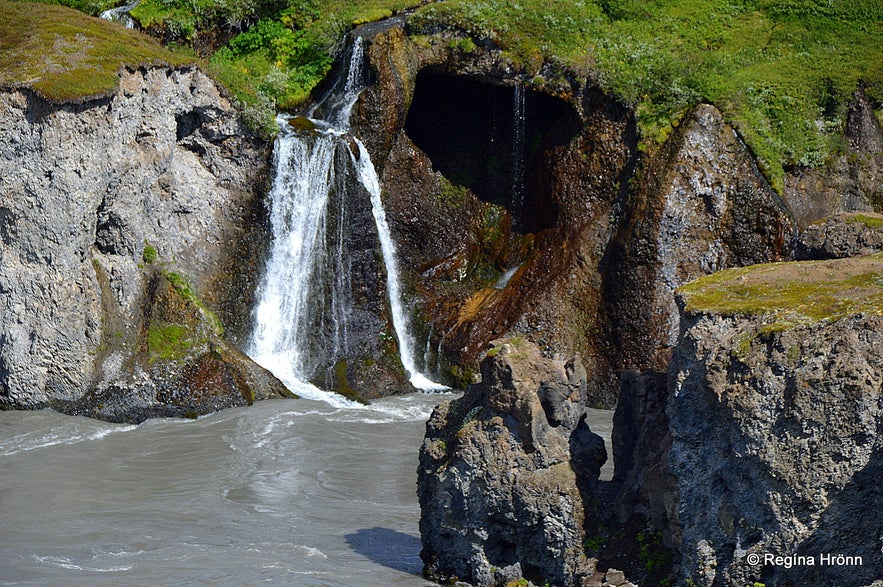 A nameless little waterfall in Hólmatungur merges with Jökulsá á Fjöllum
A nameless little waterfall in Hólmatungur merges with Jökulsá á Fjöllum
Jökulsá á Fjöllum then runs through the beautiful Hólmatungur. This is just a short preview of Hólmatungur, but I will write more in another travel-blog.
This area is so breathtaking, that I want to dedicate a special travel-blog to it.
Above is one of the pretty sights by Jökulsá á Fjöllum, but many small rivers and creeks cascade beautifully into Jökulsá á Fjöllum and add to the volume of this massive glacial river on its way to the sea.
This waterfall can be seen from Katlar in Hólmatungur.
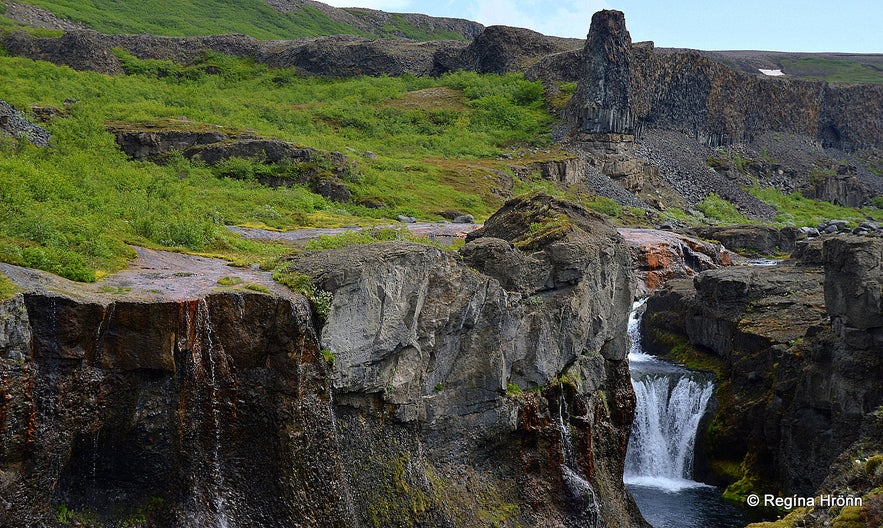 The ruggedly beautiful Jökulsárgljúfur canyon - Réttarbjarg in the distance
The ruggedly beautiful Jökulsárgljúfur canyon - Réttarbjarg in the distance
Jökulsá á Fjöllum glacial river ran in 2 river beds and in 1920 it started running into the west river bed solely with great force, but that river bed used to be the smaller one of the two branches of the glacial river.
Thus it stopped running into the east river bed where the forceful glacial river had created the massive Vígabergsfoss/Vígabjargsfoss.
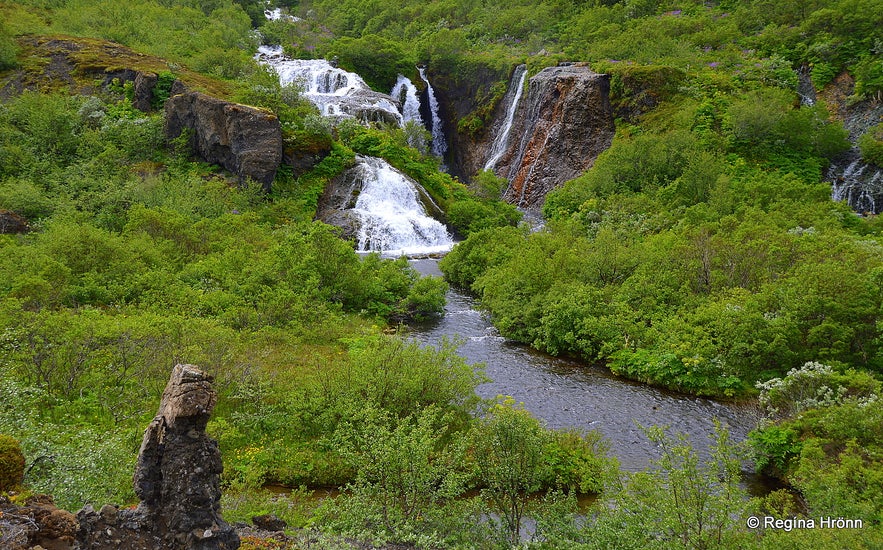 The beautiful oasis Hólmatungur in Jökulsárgljúfur canyon
The beautiful oasis Hólmatungur in Jökulsárgljúfur canyon
The only water that is left in that spot is the clear surface water from a creek coming from below Réttarbjarg cliff. (Ref. Jökulsárgljúfur by Sigrún Helgadóttir).
A lovely hike, which has now become one of my favourite hikes in Iceland, takes you from Hólmatungur to Hólmárfossar waterfalls, which cascade beautifully into Jökulsá á Fjöllum glacial river.
 Hólmárfossar waterfalls take my breath away every time I visit them :)
Hólmárfossar waterfalls take my breath away every time I visit them :)
You can either hike by the edge of the Jökulsárgljúfur canyon or by a beautiful river further up. I love that hike and will add a special travel-blog about this hike.
The photo above is taken from the south side of Hólmárfossar waterfalls and if you walk further on by the river Stallar, which is also a beautiful hike, you reach a ford in the river where the hike continues up on top of the Jökulsárgljúfur canyon and further on to Hljóðaklettar - the Echo cliffs.
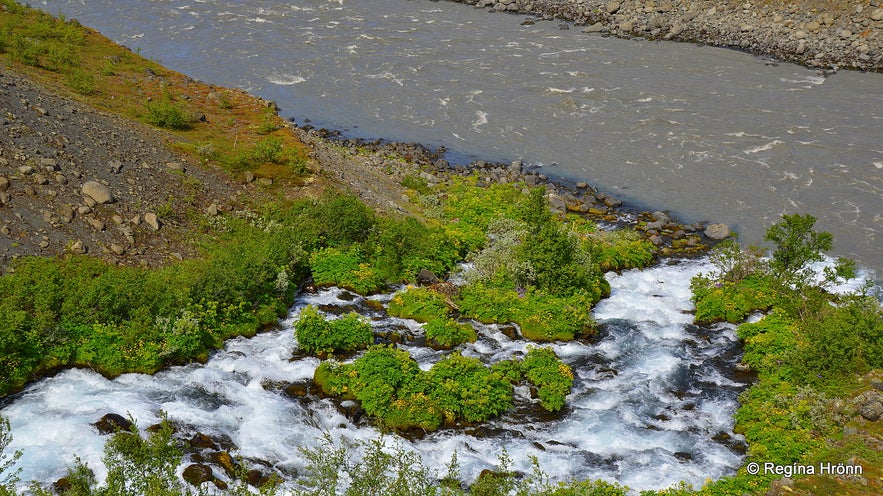 Hólmárfossar merge with Jökulsá á Fjöllum and add to the volume of the glacial river
Hólmárfossar merge with Jökulsá á Fjöllum and add to the volume of the glacial river
I passed the ford as I wanted to see where the river Stallar merged with Jökulsá á Fjöllum.
Here Jökulsá á Fjöllum is getting increasingly more forceful with all the smaller rivers merging with it.
There are many other smaller waterfalls that run into Jökulsá á Fjöllum glacial river before the river reaches the fairytale-like part of the Jökulsárgljúfur canyon called Hljóðaklettar or Echo Rocks.
I hiked alongside the Stallar river from Hólmatungur and took a video of the spot where it merges with Jökulsá á Fjöllum.
Hljóðaklettar
 Jökulsá á Fjöllum and Hljóðaklettar
Jökulsá á Fjöllum and Hljóðaklettar
Hljóðaklettar is a cluster of columnar rock formations creating all kinds of figures.
It is like entering another world and it is one of the most amazing places in Iceland, in my opinion.
These strange rock formations many of which stand by the Jökulsá á Fjöllum glacial river, are what is left of erupting volcanos some 9,000 years ago.
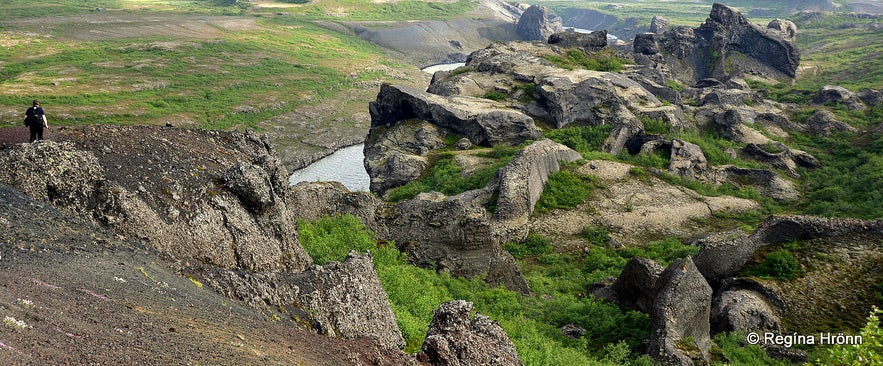 Hljóðaklettar volcanic plugs as seen from above
Hljóðaklettar volcanic plugs as seen from above
These volcanic plugs have been eroded through the centuries by the forceful currents of the Jökulsá á Fjöllum glacial river.
Catastrophic floods in Jökulsá á Fjöllum washed the volcanic material away, creating this fairytale world for us to visit.
There are several breathtaking hikes in Hljóðaklettar, one of which takes you on a hike amongst amazing basalt column formations and to the massive cave called the Church.
 The 2 trolls were too late to reach their cave and were turned into stone by Jökulsá á Fjöllum
The 2 trolls were too late to reach their cave and were turned into stone by Jökulsá á Fjöllum
I will only show you a few photos from this ruggedly beautiful place, as my travel-blog is about the glacial river Jökulsá á Fjöllum which runs in the canyon and passes Hljóðaklettar.
One of the hikes takes you down to the glacial river where you can pay a visit to Karl and Kerling, the two trolls who were out partying at night and didn't reach their cave in time.
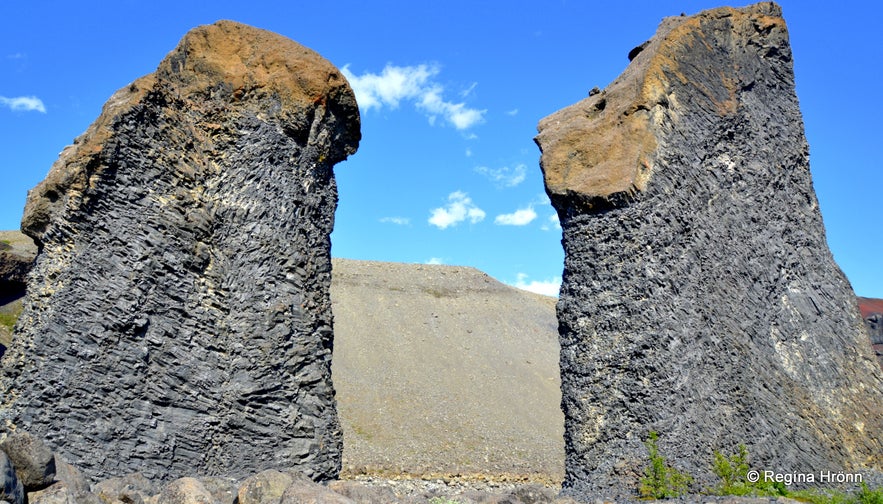 You can see how massive these trolls are by Jökulsá á Fjöllum glacial river
You can see how massive these trolls are by Jökulsá á Fjöllum glacial river
But as we Icelanders know then the night trolls (nátttröll) cannot tolerate daylight and are turned into stone if they see the first rays of the sun ;)
Usually when you see a troll couple in Iceland, then the Kerling (the Giantess) is bigger than the Karl (the Giant or Troll). But here in Hljóðaklettar, I have read that the male Troll is bigger than the female Troll.
It is well worth visiting the trolls if only to stand next to the massive glacial river Jökulsá á Fjöllum.
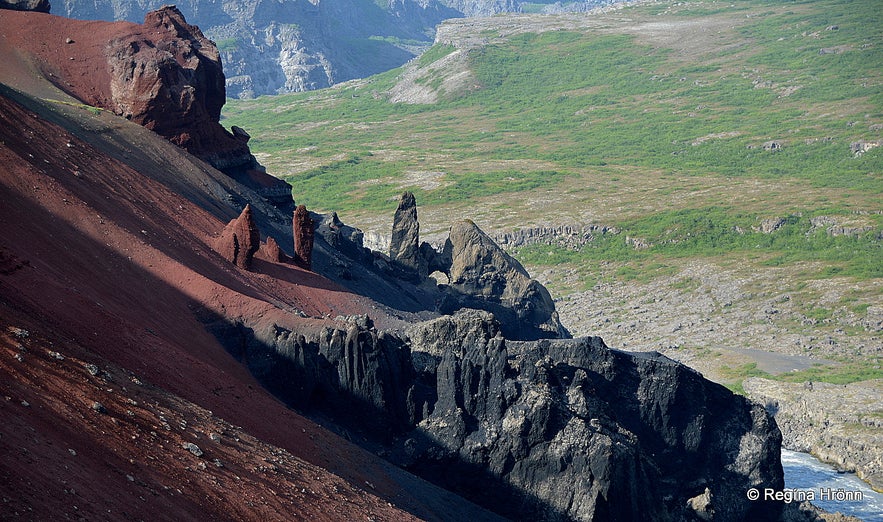 By Rauðhólar - the Red Hills by Jökulsá á Fjöllum
By Rauðhólar - the Red Hills by Jökulsá á Fjöllum
You can also hike to Rauðhólar if you have enough time to spare here at Hljóðaklettar. That hike will take you a bit further than Hljóðaklettar and it is a must in my opinion.
At Rauðhólar you will f.ex. see these two red pillars, which I find amazing. They look like they are from another planet.
 Red lava pillars at Rauðhólar
Red lava pillars at Rauðhólar
From here you have the most amazing view of Hljóðaklettar and Jökulsá á Fjöllum glacial river from above.
Further north is my favourite place in Iceland, the beautiful horseshoe-shaped Ásbyrgi. It is believed that Jökulsá á Fjöllum ran through Ásbyrgi, but changed its course and now runs east of it.
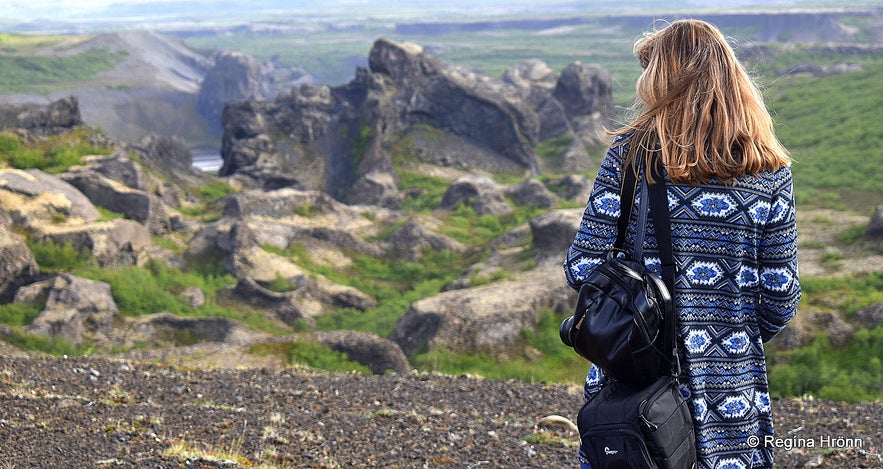 Hljóðaklettar as seen from above
Hljóðaklettar as seen from above
A little bit further north is another bridge over the river on road 85 and from there, you can see how the glacial river Jökulsá á Fjöllum runs its course in Öxarfjörður fjord after travelling for 206 km.
I guess that you understand now why the Jökulsárgljúfur canyon is my favourite canyon in Iceland and that I never tire of visiting it :)
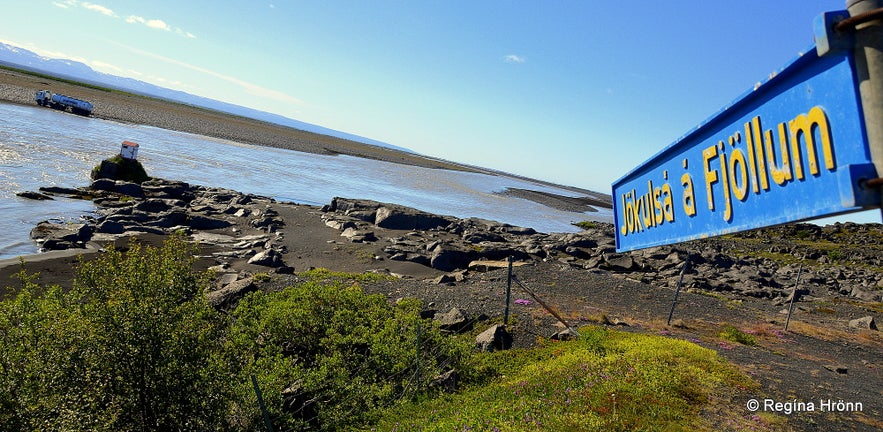 Jökulsá á Fjöllum close to the estuary of the glacial river
Jökulsá á Fjöllum close to the estuary of the glacial river
Road 862 on the west bank is now paved all the way.
It used to be paved to Dettifoss only, but in the summer and autumn of 2020, the bad gravel was finally paved, all the way down to road 85.

Jökulsá á Fjöllum glacial river
This is a summer visit only unless you join a guided tour.
I usually visit Jökulsárgljúfur on my own, but I have joined a couple of guided tours of Jökulsárgljúfur canyon and written about them in my travel-blog the Spectacular Diamond Circle in North Iceland.
Have a lovely time in the magnificent Jökulsárgljúfur canyon :)
Inne ciekawe blogi
Gorące źródła - Hrunalaug
Z czego słynie Islandia? Zorza polarna, wulkany, lodowce, gejzery i oczywiście gorące źródła! Hruni, a właściwie Hrunalaug to gorące źródło w malowniczym otoczeniu, znajdujące się w w pobliżu miejscowCzytaj więcejPolowanie na Zorzę
Zobaczenie zorzy polarnej to marzenie wielu osób. Zorza jest dla mnie czymś magicznym i niepowtarzalnym, zachwyca mnie za każdym razem. Czy faktycznie tak ciężko ją dostrzec? Otóż nauczyłam się, że niCzytaj więcejO pisaniu na Guide to Iceland
Mam wrażenie, że na Islandii bardzo wiele rzeczy staje się jasnych. Chodzi o podejście do świata, do własnej osoby, do innych, którzy realnie wpływają na Twoje życie. Islandia zmusza swoją surowościCzytaj więcej

Pobierz największą platformę turystyczną na Islandii na telefon i zarządzaj wszystkimi elementami swojej podróży w jednym miejscu
Zeskanuj ten kod QR za pomocą aparatu w telefonie i naciśnij wyświetlony link, aby uzyskać dostęp do największej platformy turystycznej na Islandii. Wprowadź swój numer telefonu lub adres e-mail, aby otrzymać wiadomość SMS lub e-mail z linkiem do pobrania.















